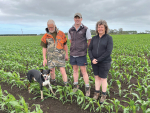New Zealand is underperforming in branding its food products, says an academic who visited recently.
Dr Damien McLoughlin, a professor of marketing at University College Dublin, says like many major food producing countries New Zealand is focused on production. But successful brands such as Coca Cola, Apple and Guinness have organised themselves around the consumer.
But he says he is shocked that no single organisation in New Zealand is responsible for branding food products.
The standout brand is Zespri, he says. Kiwifruit does an extraordinary job of delivering a premium product at a premium price – which is what branding is all about.
“NZ Inc is not doing enough to support its producers to actually reposition New Zealand strengths,” McLoughlin told Rural News.
“When I came on my first visit here 18 months ago, I noticed all the planes were black – presumably a reference to the All Blacks. When I went through the airport there are all these signs about the Lord of the Rings and I thought it was cut. “But, when I came again, it was still there and I’m asking, ‘is that the only thing this great country has to say about itself’?”
McLoughlin says New Zealand, like Ireland, is one of few countries where there is no pollution and the water and the air are clean. This proposition and image is hugely attractive to world consumers and needs to part of our brand proposition.
For a country to have a strong brand it needs an organisation dedicated solely to this, he says. By developing a strong national brand a country moves away from a ‘commodity culture’ because its brands are driven by consumer insights.
He points to a successful initiative in Ireland called ‘Origen Green’, a national branding scheme conceived by the Irish Food Board. The aim is to get farmers, producers and processors to sign up to meeting strict objectives which focus on Ireland’s clean, green image.
“The Irish Food Board… targets influential people – the big buyers of Irish food products and major retail chains and food brands around the world. It has been extremely clever and hasn’t been hugely expensive, but the money has been wisely spent.”
McLoughlin believes New Zealand has the potential to do something similar.



















